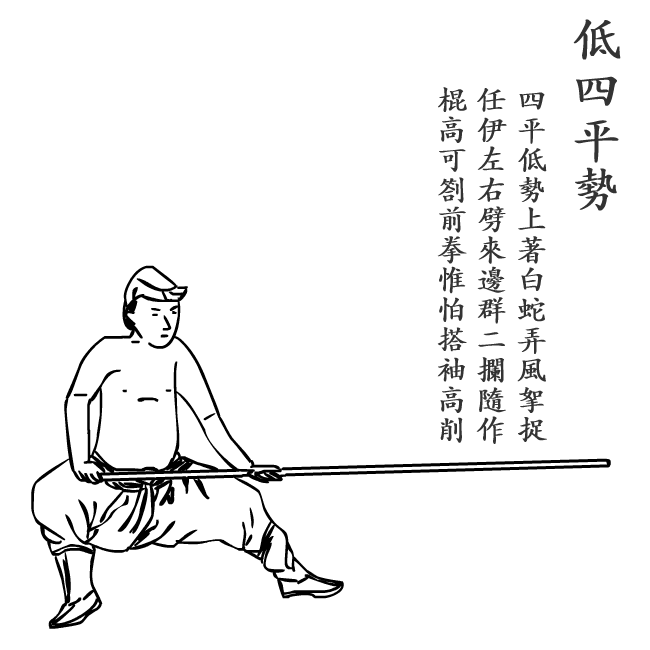《少林棍法闡宗》
Shaolin Gunfa Canzong
Shaolin Kung Fu Staff
Chief Of Weapons

少林棍法闡宗 (Shaolin Gun Fa Can Zong) is an ancient 400 years old Shaolin Staff manual, which was written by 程宗猷 (Cheng Zong You) during the Ming Dynasty, when the Japanese pirates invaded parts of China.
The author, Master Cheng Zong You, wrote and compiled a martial arts manual called 耕余剩技 (Geng Yu Sheng Ji) "Martial Arts Practiced After Farming Work", which consists of 4 volumes:
-
《少林棍法闡宗》 Shaolin Staff manual (this)
Master Cheng spent 10 years training inside the Shaolin temple and practiced with the senior Shaolin monks. This Shaolin Kung Fu manual teaches the fighting techniques of using a wooden Staff. This extensive ancient manual consists of 3 scrolls:
-
Scroll #1: Theories & Form
-
Scroll #2: Shaolin Kung Fu Staff, The 55 Stances & Techniques
-
Scroll #3: Questions & Answers
In Chinese martial arts, the Staff is considered the Chief of Weapons, because practicing it provides the foundation to be proficient in any weapon. This book is recommended for beginner to intermediate levels. For more advanced level, please read Sword Treatise.
Shaolin Staff Fighting Techniques
This is by far, the biggest and most comprehensive manual, that Master Cheng Zong You has written. The page count for this Shaolin Staff manual alone is almost the same as his other 3 manuals combined, which is the Crossbow, Spear & Long Saber.
In one documentation of the Japanese invasion, titled "吴淞甲乙倭变志" (Wu-Song Jia-Yi Wo Bian Zhi), it tells the tale of a young Shaolin monk called "智囊" (Zhi Nang). In the year 1553 June, hundreds of Ming soldiers and Shaolin monks had an encounter with the Japanese pirates.
"The enemy team had a giant cladded in red, waving his swords running towards us. The leading monk, Yue-Kong, looked at the rest of the monks and everyone looked shaken and scared. Only one monk by the name of Zhi-Nang, stood steadfast.
Monk Zhi-Nang carried a metal-staff, jumped to the left of the red-cladded Japanese and struck down, causing the enemy to drop one of his swords. The enemy rolled away and recover. Monk Zhi-Nang jump to the right of the enemy, struck away the other sword, and killed the enemy."
If you observe carefully, you'll notice that some of the stances are drawn with both hands gripping the Staff with the palms facing down. Usually the primary way of gripping the Staff is to have the front-hand's palm facing up, and the rear-hand's palm facing down.
After you've familiarized yourself with the 55 Shaolin Staff stances, you may also link them up and practice them as forms, also written in the manual.
The manual also describes how the stances can be applied in combat, some more literally, some more poetically. If you have some martial arts background previously, it should be easy to figure out the more poetically-described ones.
Documentary on Master Cheng Zong Yu (with subtitles)

A page from the Shaolin Staff manual.
Notice that both hands are palm facing down.
Bringing The Ancient Manual Back To Life
Video demonstration of the Shaolin Kung Fu Staff
Stances #1 to #11 as documented in the manual.
Most of the Shaolin Staff videos found on YouTube are practiced in a more 'flowery' manner, that's good for performances on stage, but may not bring out the combat practicality behind the techniques.
So we decided to make a video that is specifically based on what's written in this Shaolin Staff manual, with only a few movements, because that's all it takes to end a fight with a weapon.
I used my own existing martial arts background to execute my interpretation of what's written in the manual. If you have a different martial arts background, the way you execute the techniques may be different.
Nevertheless, I hope I've sufficiently demonstrated the essences and principles behind the techniques in my videos. Because these will always be the same, no matter how you may choose to execute them.
Video demonstration of the Shaolin Kung Fu Staff
Stances #12 to #22 as documented in the manual.
Spreading The Shaolin Staff Legacy
If you can master the Staff, you'd have created a good foundation in fighting with other weapons. Shaolin monks are revered for their skills in the Staff, hence this comprehensive ancient manual will serve you well in the practice of weaponry combat.
My vision is to see more martial artists practicing the techniques in ancient Chinese martial arts manuals, so that the art can be passed on for future generation.
I've attempted to translate this manual as literally as possible, so that the interpretation is open to anyone of any martial arts background. The English translated version of this Shaolin Staff manual was finally launched on August 2011.
Every single line of text is translated individually, so that I'm forced to work on every single word. This prevents me from skipping over difficult words, and helps to ensure that the translation is as precise and complete as possible.
Features to help you learn & understand:
-
Hanyu Pinyin pronunciation for all Chinese text
To help you pronounce the stances' names accurately. -
Chinese text side-by-side with the English translation
For your reference to the meaning of every word.
English Translation - Scroll #1
Theories & Forms
Contains solo-practice forms, as well as drills that you can practice with a partner. However, you will need to understand the stances in Scroll #2 first.
Also, it will be easier for you to understand and practice the information in this scroll if you have some martial arts background beforehand.
Contents (150 pages, A5-size):
-
General Theory
-
Small Yaksha: 1st Staff Form
-
Small Yaksha: 2nd Staff Form
-
Small Yaksha: 5th Staff Form
-
Big Yaksha: 1st Staff Form
-
False-Grip: 1st Staff Form
-
Staff Defense 1st Form
-
Staff Defense 2nd Form
-
Staff Defense 3rd Form
-
Staff Defense 4th Form
-
Staff Defense 5th Form
-
Staff Defense 6th Form
-
Staff Defense Another 2nd Form
-
Staff Defense Another 4th Form
-
Staff Defense Another 6th Form
Shaolin Kung Fu Staff: Scroll #1 Preview
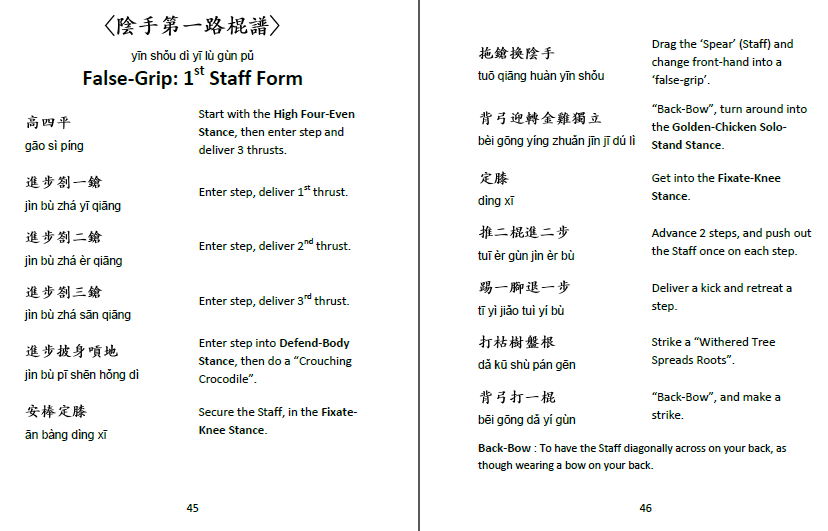
Shaolin Staff Translation Preview #1
Form practice with the Shaolin Kung Fu Staff.
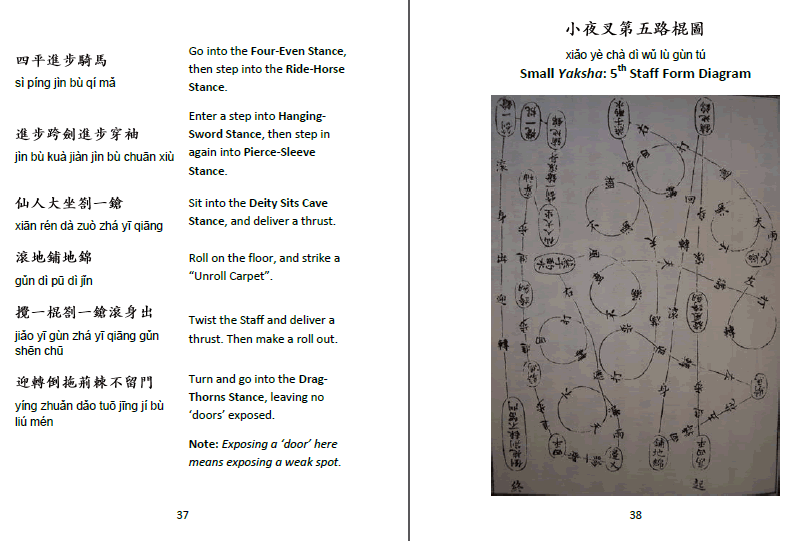
Shaolin Staff Translation Preview #2
Diagram showing the practice movements.
Download the English translated
Shaolin Staff Scroll #1 Instantly
English Translation - Scroll #2
Stances
There's a total 55 Shaolin Staff stances in Scroll #2. Each stance is generally described quite pragmatically.
After you've understood these stances, you can link them up in sequence to practice as forms described in Scroll #1.
If you're new to this Shaolin Staff manual, I would suggest that this Scroll #2 to be the first scroll that you should get. Then subsequently, you can get Scroll #1 then Scroll #3.
Contents (115 pages, A5-size):
-
1 Staff & 3 Spears Models Diagram
-
The 55 Shaolin Staff Stances
Shaolin Kung Fu Staff: Scroll #2 Preview
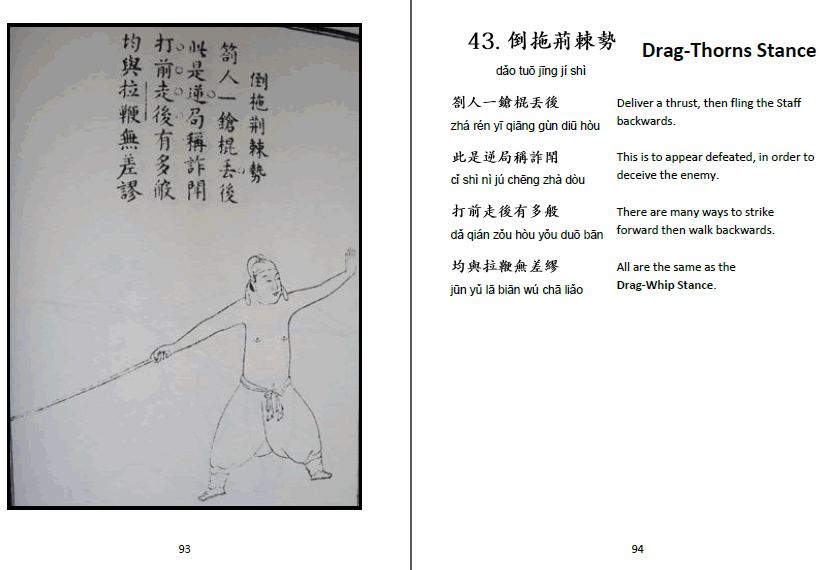
Shaolin Staff Translation Preview #1
The Drag-Thorns Stance.
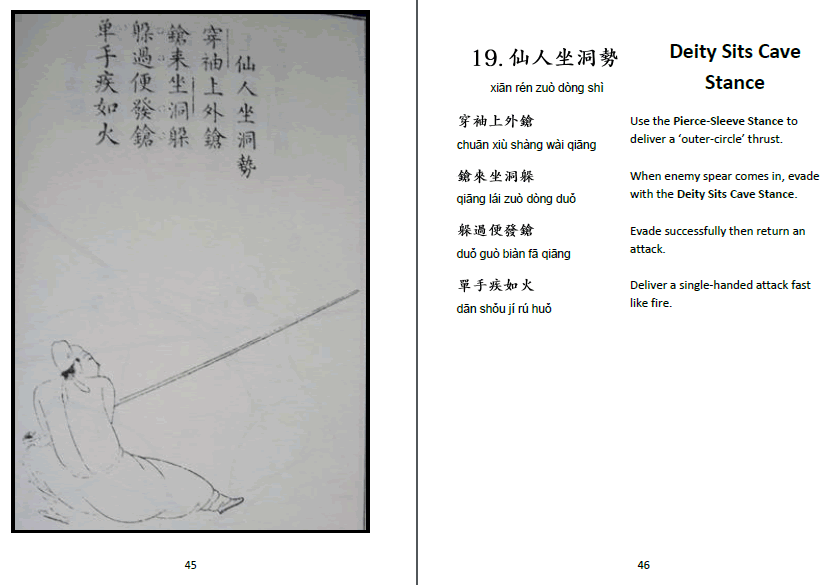
Shaolin Staff Translation Preview #2
Deity Sits Cave Stance
Download the English translated
Shaolin Staff Scroll #2 Instantly
English Translation - Scroll #3
Questions & Answers
This scroll consists of 40 questions addressed to Master Cheng, followed by his answers.
It discusses in-depth principles, tactics, strategy and history. If you've been practicing martial arts for some time, you'll definitely appreciate this Q&A scroll.
Even if you've not practiced the Staff, but you've practiced other weapons, the answers in this Q&A scroll can still be applicable.
Contents (131 pages, A5-size):
-
Questions & Answers
Shaolin Kung Fu Staff: Scroll #3 Preview

Shaolin Staff Translation Preview #1
Questions & Answers
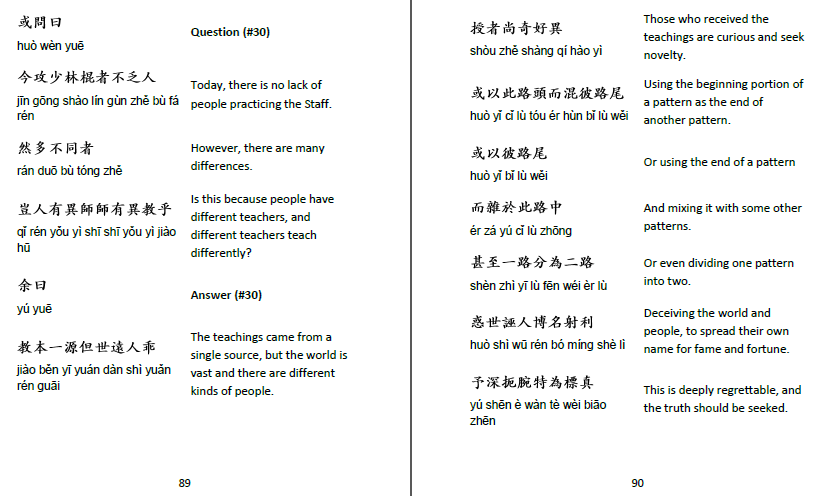
Shaolin Staff Translation Preview #2
Questions & Answers
Download the English translated
Shaolin Staff Scroll #3 Instantly
Video Learning Series
"Evade and Deceive"
Touted as the most important technique that you'll need to know, in order to fight with the Shaolin Staff (or any weapon for that matter), is the 閃賺 "Evade-and-Deceive" technique.
It is mentioned throughout the Shaolin Staff manual, and without knowing how to perform "Evade-and-Deceive", you'll find that it's hard to win a fight cleanly. But once you master this technique, you will find that you will begin to win sparring matches without getting yourself hit in the process.
Hence I've created this Video Learning Series to help you to understand this important technique. Find out more here: www.ChineseLongsword.com/evade.
Contents (40 mins, 11 videos):
-
Introduction
-
Basic Terminology
-
Evade-and-Deceive Explanation #1
-
Evade-and-Deceive Explanation #2
-
Pierce Lift Explanation
-
Old Energy, New Energy
-
Reduce Your Gap
-
Practice Slowly
-
The "Scissors" Stance
-
"Black Dragon Overturns River" Stance
-
"Hug Pipa" Stance
Your contribution and support will help us to continue running this website, and further the research of ancient Chinese battlefield arts.
Thank you,
Jack Chen
Download the Video Series
for "Evade-and-Deceive" immediately


